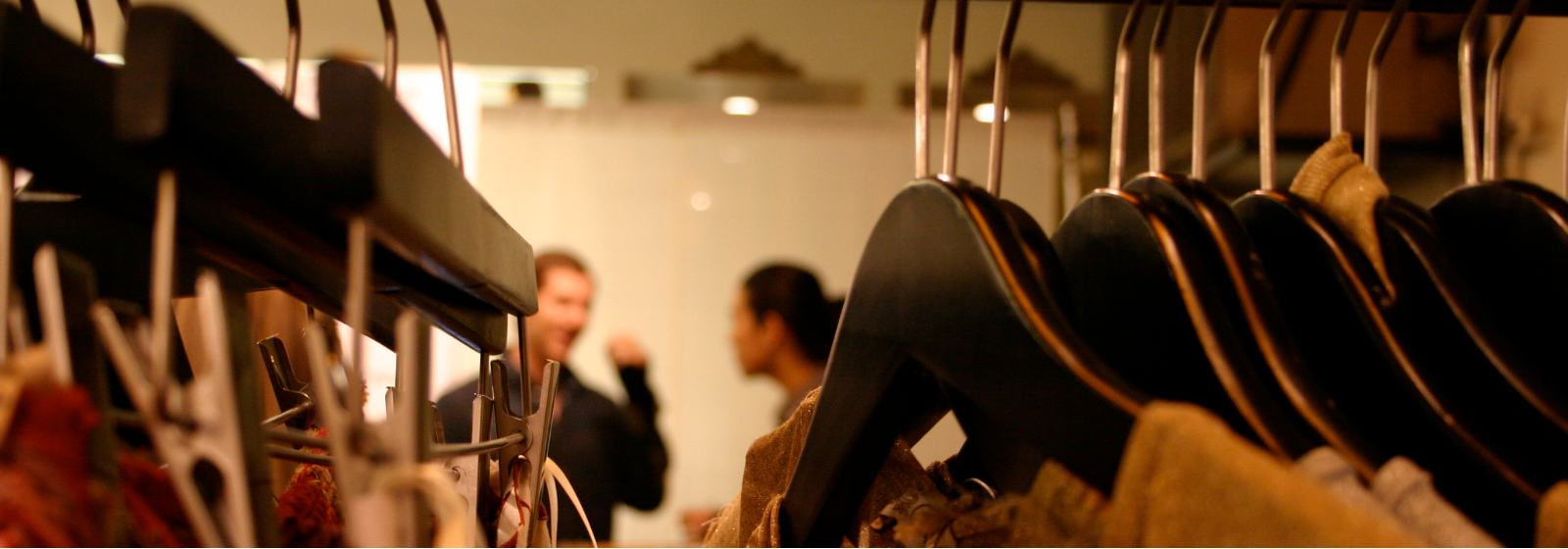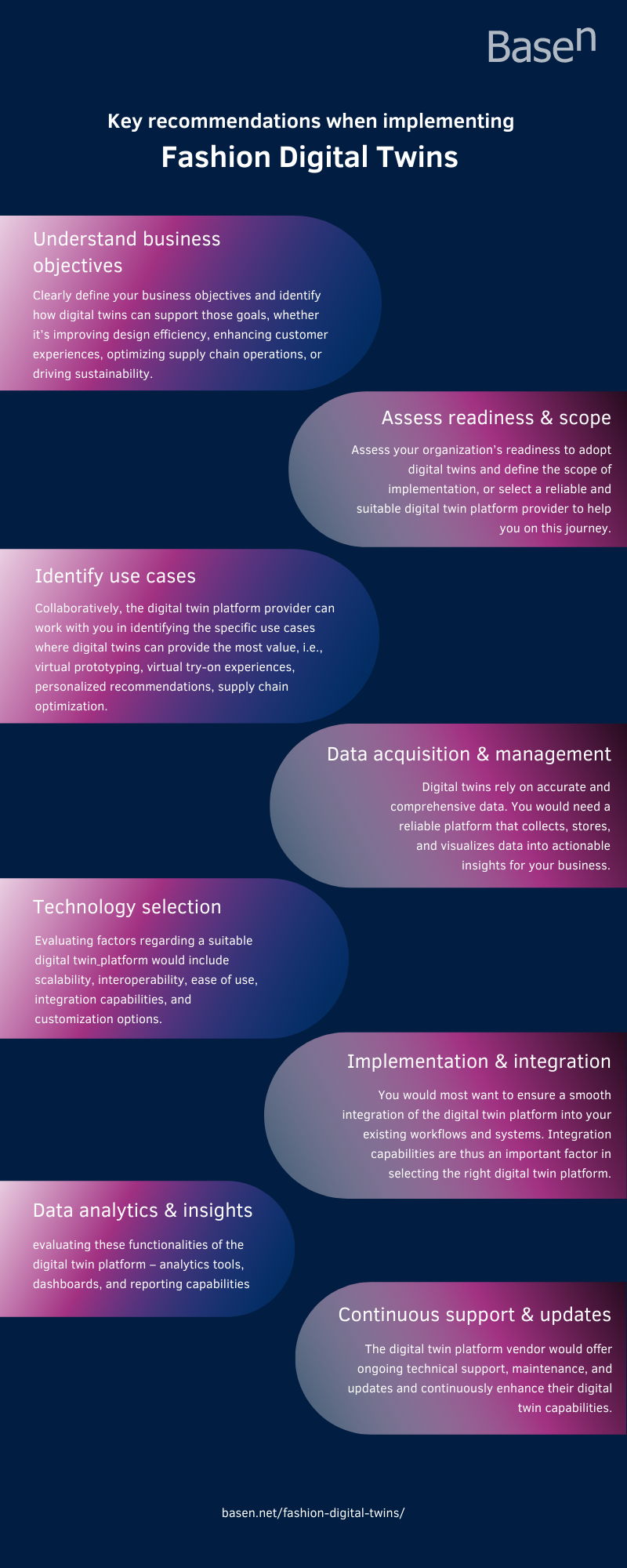Fashion digital twins are virtual representations of physical fashion products or designs. A fashion digital twin captures the detailed characteristics of a physical garment, including its shape, texture, color, and other visual attributes.
Here are some reasons why fashion digital twins have emerged:
- Design Iteration and Efficiency: Fashion designers traditionally rely on physical prototypes and samples to iterate and refine their designs. This process can be time-consuming and costly. Fashion digital twins allow designers to create virtual prototypes, enabling rapid iteration and reducing the need for physical samples. It accelerates the design process and enhances overall efficiency.
- Enhanced Customer Experience: Fashion digital twins offer an immersive and interactive experience for customers. Virtual try-on capabilities enable customers to visualize how a garment would look on them without physically trying it on. This enhances the online shopping experience, reduces purchase uncertainty, and improves customer satisfaction.
- Personalization and Customization: Fashion digital twins enable personalized and customized experiences for customers. By creating virtual avatars and using digital twin technology, retailers can provide personalized recommendations, simulate how different garments would fit and look on an individual’s body, and offer customized design options. This enhances the customer’s sense of ownership and engagement with the brand.
- Supply Chain Optimization: The fashion industry’s supply chain is complex, involving multiple stakeholders, production processes, and logistics. Fashion digital twins can be integrated into the supply chain to optimize inventory management, production planning, and distribution. By digitally tracking each garment’s lifecycle, companies can reduce waste, improve inventory accuracy, and streamline operations.
- Sustainability and Circular Economy: Fashion digital twins contribute to sustainability efforts within the fashion industry. By reducing the reliance on physical samples and prototypes, they minimize material waste. Digital twins also facilitate the creation of virtual showrooms, reducing the need for physical fashion events and their associated environmental impact. It aligns with the goals of a circular economy, promoting resource efficiency and reducing waste generation.
- Data-Driven Insights and Analytics: Fashion digital twins generate valuable data throughout the design, production, and customer engagement processes. This data can be leveraged to gain insights into customer preferences, optimize designs, improve manufacturing processes, and make data-driven business decisions. It enables fashion brands to better understand their customers and tailor their offerings accordingly.
- Innovation and Differentiation: Fashion digital twins provide a platform for innovation and differentiation within the fashion industry. By embracing advanced technologies like 3D modeling, computer vision, and artificial intelligence, brands can showcase their creativity, experiment with new designs, and offer unique experiences to customers. It allows brands to stand out in a competitive market and capture consumer attention.
Needs and challenges for implementing fashion digital twins
But, while fashion digital twins offer numerous benefits, there are also some needs and challenges associated with their implementation. Below are a few key considerations:
Data Acquisition and Standardization: Creating accurate and detailed digital twins requires high-quality data. This includes capturing precise measurements, textures, and colors of garments. Obtaining this data can be challenging, especially when dealing with complex fabric patterns or intricate designs. Standardizing data formats and establishing industry-wide data collection guidelines are necessary for interoperability and widespread adoption.
Realism and Accuracy: Achieving a high level of realism and accuracy in fashion digital twins is crucial for their effectiveness. The virtual representation should closely resemble the physical garment, capturing its shape, drape, and texture. Ensuring accurate color representation is particularly important since colors can appear differently in digital and physical environments.
Scalability and Efficiency: As the fashion industry produces a vast number of garments, scalability, and efficiency are crucial. Generating digital twins for each item can be time-consuming and resource-intensive. Streamlining the process through automation and leveraging advanced algorithms can help achieve scalability while maintaining accuracy.
Integration into Existing Workflows: Incorporating fashion digital twins into existing design and production workflows can be a challenge. It requires integrating new technologies, software tools, and processes into established systems. Ensuring compatibility and seamless integration with existing software platforms and equipment is essential for wider adoption.
Cost Considerations: Developing and implementing fashion digital twins may involve initial investment costs. These costs can include acquiring technology infrastructure, training personnel, and updating existing systems. Fashion brands and manufacturers need to evaluate the cost-benefit ratio and assess the long-term value of digital twins in their operations.
Data Privacy and Security: Fashion digital twins involve collecting and processing large amounts of data, including sensitive customer information. Protecting this data from unauthorized access and ensuring privacy is crucial. Fashion companies need to implement robust security measures and adhere to data protection regulations to build trust with their customers.
Industry Collaboration and Standards: Collaboration among industry stakeholders, including fashion brands, manufacturers, technology providers, and standards organizations, is vital for advancing fashion digital twin technology. Establishing common standards, sharing best practices, and fostering collaboration can drive innovation, interoperability, and widespread adoption of fashion digital twins.
Key recommendations when implementing fashion digital twins
Despite these challenges, in the bigger picture, the potential benefits of fashion digital twins make them an exciting area of development within the fashion industry.
With our over 20 years of experience in creating full situational awareness for any business with digital twins, we see that the biggest challenge of all though is not enough trust or desire to transform your businesses. So, setting up fashion digital twins ultimately begin with a change in mindset, especially in terms of leadership and management.
But, there are a few other key recommendations we see valuable for fashion businesses to consider when heading for fashion digital twins:
- Understand Business Objectives: Clearly define your business objectives and identify how digital twins can support those goals. Whether it’s improving design efficiency, enhancing customer experiences, optimizing supply chain operations, or driving sustainability, a thorough understanding of the desired outcomes is crucial.
- Assess Readiness and Scope: Assess your organization’s readiness to adopt digital twins and define the scope of implementation, or select a reliable and suitable digital twin platform provider to help you on this journey. This involves evaluating existing infrastructure, software systems, and data management capabilities.
- Identify Use Cases: Collaboratively, the digital twin platform provider can work with you in identifying the specific use cases where digital twins can provide the most value. This could include virtual prototyping, virtual try-on experiences, personalized recommendations, supply chain optimization, or any other relevant applications. The platform provider, as an expert in digital twins, would provide insights into best practices and examples from similar implementations.
- Data Acquisition and Management: Digital twins rely on accurate and comprehensive data. You would need a reliable platform that collects, stores, and visualizes data into actionable insights for your business. You would want to select a digital twin platform provider with experiences on data acquisition techniques, and data management, including data standardization, storage, and security considerations. Working with the experts in digital twin technology will help save time and resources for you in this matter, which you can allocate to improve your business in areas that you know best.
- Technology Selection: Evaluating factors regarding a suitable digital twin platform would include scalability, interoperability, ease of use, integration capabilities, and customization options.
- Implementation and Integration: You would most want to ensure a smooth integration of the digital twin platform into your existing workflows and systems. Integration capabilities are thus an important factor in selecting the right digital twin platform. And when you work with a digital platform provider, they should be your support throughout the implementation process. They would provide technical expertise, training, and documentation to enable a successful adoption. Customization and configuration of the platform to align with specific requirements would also be part of the vendor’s support.
- Data Analytics and Insights: Once the digital twin platform is operational, it would be time for you to leverage the generated data to gain insights and make data-driven decisions. This involves evaluating these functionalities of the digital twin platform – analytics tools, dashboards, and reporting capabilities.
- Continuous Support and Updates: The vendor would offer ongoing technical support, maintenance, and updates for the digital twin platform. They would stay informed about emerging technologies and industry trends to ensure that the fashion industry stakeholders can leverage the latest advancements and continuously enhance their digital twin capabilities.
With the rapid adoption of digital twins now, businesses should also act as soon as possible.
In conclusion, the concept of fashion digital twins has gained recognition and momentum in recent years. Fashion digital twins offer several benefits, including design iteration and efficiency, enhanced customer experiences, personalization and customization, supply chain optimization, sustainability and circular economy practices, data-driven insights, and analytics, as well as innovation and differentiation opportunities.
However, the implementation of fashion digital twins also presents challenges, such as data acquisition and standardization, achieving realism and accuracy, scalability and efficiency, integration into existing workflows, cost considerations, data privacy and security, and the need for industry collaboration and standards.
To successfully adopt fashion digital twins, businesses should consider understanding their objectives, assessing their readiness and scope, identifying specific use cases, managing data acquisition and standardization, selecting the right technology platform, ensuring smooth implementation and integration, leveraging data analytics and insights, and receiving continuous support and updates from a reliable digital twin platform provider.
Additionally, a change in mindset, particularly in terms of leadership and management, is crucial for embracing digital transformation. With the right approach and collaboration with experts in digital twin technology, fashion companies can harness the potential benefits and overcome the challenges associated with fashion digital twins.
With the rapid adoption of digital twins now, businesses should also act as soon as possible. Fashion digital twins are not the finish stops. At BaseN, we already recognize next-generation digital twins – the virtual master objects that can control and influence their real-world counterparts. Next-generation digital twins go a step further than digital twins by incorporating autonomy and adaptation capabilities. These virtual masters will offer unprecedented capabilities and potential for innovation. But, more on that later. First, we recommend you familiarize with next-generation digital twins.






3 replies on “Fashion digital twins ”
Dear basen.net webmaster, Thanks for the well-organized post!
To the basen.net admin, You always provide practical solutions and recommendations.
Dear basen.net owner, Your posts are always a great source of knowledge.